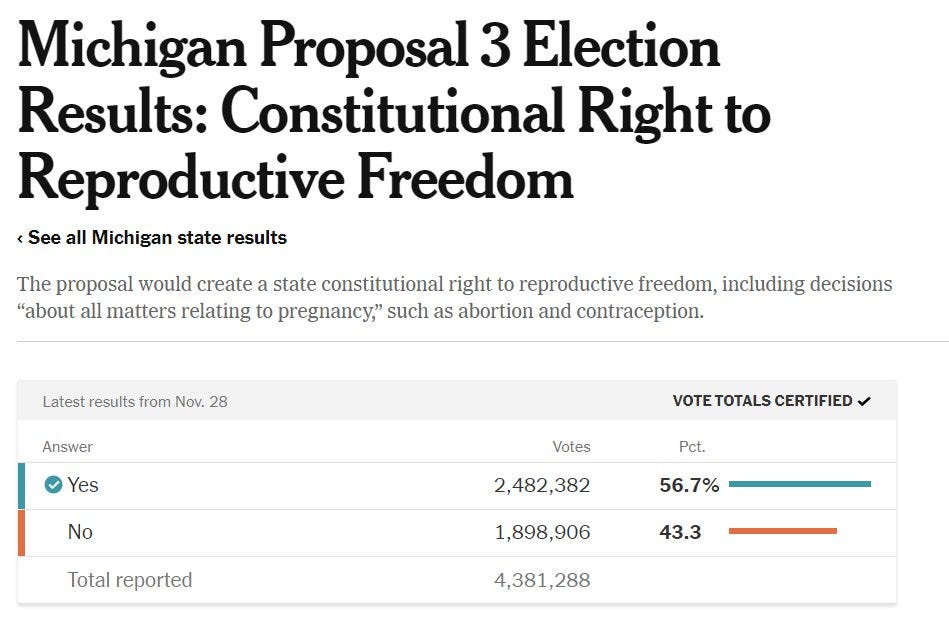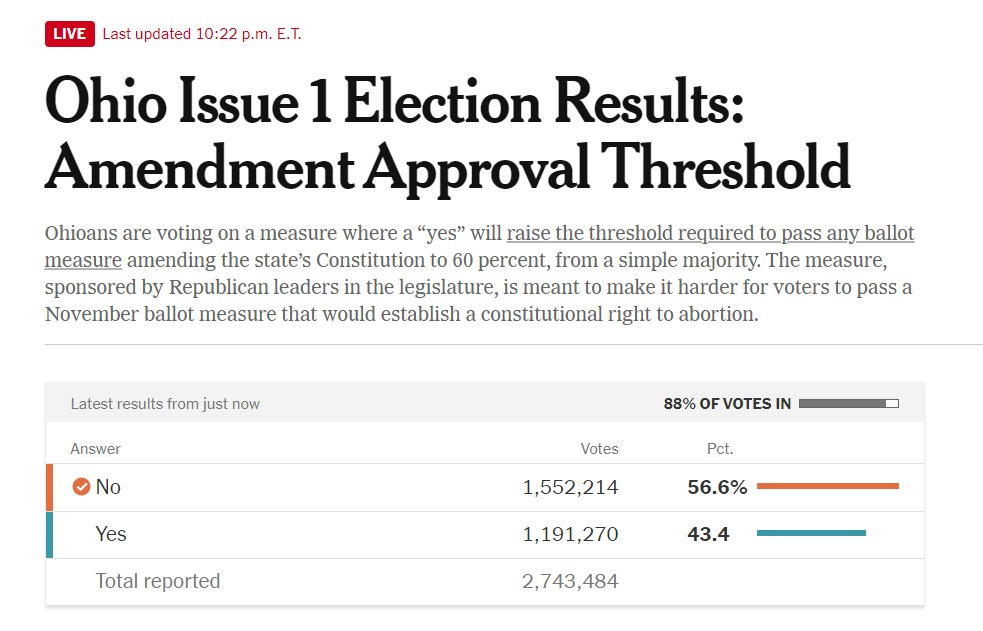
It was a sneaky, underhanded attack on the democratic process, but that’s par for the course in GOP-controlled Ohio.
But it didn’t work. In fact, it went down in flames.
On the Ohio ballot on Tuesday was Issue 1, which would have raised the threshold for passage of any initiative-driven state constitutional amendment from 50 to 60 percent. It would do this while imposing onerous new ballot qualification requirements that only the largest, most organized, most well-funded interest groups could ever meet.
Hours after polls closed yesterday, the “No” vote on Issue 1 led by 57 to 43 percent—a whopping 14 points—with most precincts reporting. Early returns were so lopsided against the measure that Cook Political’s Dave Wasserman called the race at 7:55 p.m., and Decision Desk HQ called it at 8:09 p.m. Not a nail biter after all.
“Ohio, we did it. Tonight is a major victory for democracy in Ohio,” said Dennis Willard, a spokesman for One Person, One Vote, a coalition working to defeat the measure. “The majority still rules for democracy in Ohio. The people’s power has been preserved.”
At its core, the measure was a politically-driven effort to stop abortion rights from being enshrined into law this November, when voters will decide whether the pre-Dobbs right to abortion should be guaranteed by way of state constitutional amendment. Republicans placed Issue 1 on the August ballot precisely to head off that effort, after expressly voting earlier never to hold elections in August because they were expensive and traditionally had low turnout.
But yesterday saw anything but low turnout. Even for a single issue election, there was a record-breaking 38 percent turnout rate, similar to that of a gubernatorial election. The election resulted in a resounding rejection of Republican electoral tricks and of minority rule, and it was a strong indication that voters are exhausted by and have had it with GOP extremism on abortion rights and other cultural and social issues.
The win in Ohio, amazing as it is for progressives in a traditionally red, Trump-voting state, also carries many important takeaways with implications for the future of democracy in Ohio and for big national battles in 2024. Let’s walk through a few today.
Abortion rights remains a big winner and motivator
There have now been seven statewide elections since Dobbs overruled Roe v. Wade, and abortion rights advocates have prevailed in every single one.
Four of these contests were won in states considered solidly red: Kansas, Kentucky, Montana and now Ohio. I include Ohio because voters there plainly understood what the stakes were in yesterday’s election: that this was really about the GOP trying to make it far harder to pass an abortion rights amendment in November.
In swing states like Michigan and Wisconsin, abortion rights figured heavily into recent election wins, returning a trifecta of Democratic rule to Michigan in 2022 and flipping the Wisconsin state Supreme Court from conservative to liberal control in 2023.
Indeed, the results of the Michigan abortion referendum, compared to the returns on neighboring Ohio’s Issue 1, are strikingly similar, as one observer noted: around 57 to 43 percent in both states.
Such wins carry big political repercussions. Michigan held one of the state’s most progressive legislative sessions in recent memory, with new bills strengthening reproductive rights, voting rights and gun safety. And Wisconsin courts will finally be reviewing the state’s recent redistricting—one that maintained GOP supermajorities and sent a Republican-dominated delegation to Congress from a state that is evenly split.
With so many electoral set-backs around abortion, you’d think that the GOP would put the brakes on more extreme abortion bans. As conservative commentator Patrick Brown tweeted,
The Ohio result tonight, coming on the heels of the shellacking in Michigan and the unexpected loss in Kentucky, needs to be a five-alarm fire for the pro-life movement.
[T]he playbook being run by the pro-choice side is very clear. The cause of life has to adapt, even if that means unwelcome compromise for the time being. We’ll keep getting run into the ground if we don’t.
But getting run into the ground appears to be what they have chosen. Indeed, the GOP keeps doubling down on its extremism, with a national abortion ban still front-and-center on the agenda of many leading GOP candidates for president, and draconian six-week abortion laws still passing in states like Florida.
This could, and likely will, spell electoral disaster for the Republican Party in 2024 should it continue.
Voters are on to the GOP’s games
For all their baseless accusations about rigged elections, the GOP sure attempts a lot of election rigging of its own. This comes in many forms, but Ohio’s Issue 1 was one of the most blatant and cynical power grabs. It underscored the suspicion, now shared by many voters, that the GOP knows it can’t win by the rules and so either tries to change those rules mid-game or cries “fraud” when it loses.
That has left a sour taste in the mouths of many voters, including independents and persuadable Republicans. Huge numbers of such voters in the 2022 midterms, especially in the all-important swing states, crossed over to reject election denialists up and down the ballot. And many of those same voters smelled a rat with Issue 1 and also rejected it outright.
It’s important to put the Issue 1 fight into larger context, because it wasn’t ever meant to end there. Ohio was a testing ground for future electoral shenanigans, in which similar supermajority requirements would be erected across the red states in order to prevent the majority from actually having a true voice and say. As I wrote in a piece yesterday for The Big Picture (a substack that I highly recommend you also subscribe to!), a conservative nonprofit group calling itself the Foundation for Government Accountability has been involved in efforts in other states to raise the threshold for constitutional amendments. One of its benefactors is an Illinois shipping magnate and billionaire named Richard Uihlein, who also put millions of his own money into the Issue 1 race.
The political shift in Ohio could mean we hold the Senate
Wait, what does Issue 1 have to do with control of the U.S. Senate? Wasn’t that just a state law question?
Indulge me a minute here.
Ohio is one of the three Senate seats in play in 2024 in states that voted heavily for Trump but are currently represented by at least one Democratic senator. (The other two are Montana and West Virginia—more on that to come in future installments.) Sen. Sherrod Brown won his election handily in 2018, but that was a blue wave year for Democrats. In 2024, he will be on the ballot along with Biden and Trump, and he will need strong Democratic turnout and for some independent and some Republican voters to cross over.
Because Democrats currently hold a one-seat majority, if Sherrod Brown keeps his seat, the GOP will have to win in both the other states to seize back control of the chamber.
A fired-up base of progressives, along with more moderate Republicans and independents who might vote to reject political extremism, could do the trick. As the Columbus Dispatch reported with respect to Issue 1,
“No” votes poured in from progressive strongholds around Columbus, Cincinnati and Cleveland, but the measure also garnered opposition from voters in key GOP areas. For example, nearly 58% of voters in suburban Delaware County north of Columbus rejected Issue 1 despite the county’s long history of supporting Republicans.
The same percentage of voters opposed Issue 1 in Mahoning County. The blue-collar county was once safe Democratic territory, but it’s now driven by populist conservatives who support former President Donald Trump.
And as analyst Dave Wasserman noted, “It looks like Ohio Issue 1 is going to fail in Delaware Co. (northern Columbus burbs), which has voted Republican in every presidential race since 1916 and didn't even vote for Sherrod Brown in 2018.”
Brown’s campaign today is no doubt poring over these numbers and is thrilled with this opening. It means abortion and anti-democratic extremism are wedge issues for the GOP that Brown can exploit in Ohio. And that means we could hold the Senate if, for example, Jon Tester of Montana can do the same.
Further, Issue 1 may wind up hurting the political fortunes of one of Sen. Brown’s chief rivals. The current Secretary of State, Frank LaRose, is running to be the GOP nominee to take on Brown. LaRose has been one of the most vocal proponents of Issue 1 and is largely credited for linking it directly to abortion. Last week, LaRose went on record to state, “We’re talking about protecting the state constitution, yes against a radical abortion amendment,” adding that it also protects against minimum wage increases and safeguards gun rights, among other things. (Such horrible things, I know.)
But voters didn’t buy it, and they might not buy LaRose over Brown should he become the GOP nominee.
Voters can counter gerrymandering and protect important rights
In my piece yesterday in The Big Picture, I briefly laid out the history of GOP gerrymandering in Ohio, at least since it first began in earnest at the turn of the century. It shows that Ohio is not so much a “red” state as it is a vote-suppressed state. And one way around that suppression is for voters statewide to seize back control of the redistricting process, as they have done in neighboring Michigan.
Author Ari Berman, who writes passionately about voting rights in America, boiled it down well:
Trump won 53% of vote in Ohio but GOP controls 67% of seats in state house & 79% in state senate
That’s why defeat of Issue 1 such a big deal
Voters can still use direct democracy to check power of ultra gerrymandered legislature & protect fundamental rights
If progressive forces can succeed this November in enshrining abortion rights into the state constitution, they could set their sights, as Michigan voters did, on reforming the redistricting process in order to create a truly independent map drawing commission, and not one stacked with GOP cronies.
Progressives could build upon the strength of the coalition, now under the flag of the One Person One Vote, and take their fight to the ballot box in 2024 to force real political reform through statewide initiative. The big victory on Issue 1 showed the world that Ohio is still very much in play and that its citizens want to take back control of their democracy.
Now it’s time to keep the momentum going.


















It shows progress for women's rights despite the right wing extremist efforts to roll them back. Just ten years ago, a measure like this may have passed. In fact Republicans used anti-abortion folks to win elections, and now it's backfiring on them instead. Let's hope the same holds true for their anti-gay/trans pretentious morality garbage and their invasion of schools to try to teach ignorance and hate.
Is it just me or are the GOP legislators and candidates learning NOTHING from their defeats? People told them VERY clearly: we want abortion rights, we want to end gerrymandering, we want the sensible gun law reform, we want to tax the wealthy. Republicans keep losing over and over because of their inflexible stance on those issues, particularly abortion rights - yet they keep doing the same thing. Do they not understand that even a handful of sensible, moderate Republican candidates could seriously revive the party? I get that all they care about is power - but don't they see that power is precisely what their losing thanks to their own pigheadedness?